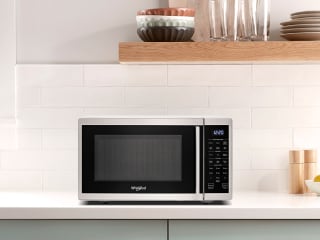
Microwave sizes: finding the right fit
Shopping for a new microwave oven? Do a little research on countertop and over-the-range microwave dimensions and capacities before you buy so you can find the right size for your space and cooking needs. A new microwave can help free up some counter space or streamline mealtime with the latest features, like this Whirlpool® Microwaves with Air Fry Mode.
Not sure where to start? Keep reading to learn more about external and internal sizes for different microwaves types, then check out: How to choose the right microwave.
What are standard microwave sizes?
There are two measurements to consider when determining what size microwave to buy. The external dimensions, measured in inches, determine the overall size of the microwave and help you identify how much space you’ll need to accommodate your appliance. The internal dimensions (i.e., capacity, which is measured in cu. ft.) indicate how much cooking space is available inside the microwave. Depending on space constraints in your kitchen, the depth of the appliance may be the most important factor in determining which size microwave is right for you.
Let’s take a look at the different microwave styles and configurations available:
Countertop microwaves
A countertop microwave can be placed almost anywhere in your kitchen or installed in cabinetry with a trim kit for extra flexibility and easy access.
Interior space ranges from 0.5 cubic feet (usually considered compact microwaves) to over 2.0 cubic feet.
Exterior width ranges from roughly 15 inches for compact microwaves to 24 inches for larger units.
Remember to consider the depth of the microwave with the door open to make sure you have enough space for the full swing-out.
◦ Closed-door depths range from roughly 14" to 20"
◦ Open-door depths range from roughly 27" to 39"
Shop countertop microwaves from Whirlpool brand to find the perfect combination of size and features for your family. Cook food in microwave-safe containers of almost any size with our largest countertop microwave, or bring home a compact 0.5 cubic foot microwave perfect for that unused corner of your countertop.

Whirlpool® Microwaves
A microwave for every home
From countertop options to microwave hood combinations, find the right fit for your family with microwaves from Whirlpool brand
Over-the-range microwaves
Over-the-range microwaves help free up counter space and even vent out kitchen odors from the range below.
Interior space usually ranges from 0.8 cubic feet for compact microwaves up to 2.1 cubic feet for full-sized models.
Widths will usually be roughly 30" to match the standard width of the range below and the standard cabinet width where the microwave will be mounted.
Most over-the-range microwaves are roughly 17" tall, while low profile microwaves are around 10-5/16" tall.
- Closed door depths can range from 15" to 18" or 12-¾" for flush built-in design.1
- Open-door depths will run from 42" to 45", but the standard width of over-the-range microwaves ensures that all models will have a similar swing-out radius. Expect over-the-range microwaves to extend beyond the surface of your cabinets.
For a more seamless look, elevate your kitchen with a style that stands out and a microwave that fits in with the Flush Built-In Design, like on this Whirlpool® Microwave. When closed, the door sits flush with standard depth cabinets.
If this style sounds like a good fit for your family, shop a full lineup of over-the-range microwaves from Whirlpool brand. You’ll find compact over-the-range microwaves, low profile models and 2.1 cubic foot capacity microwaves with features like steam and sensor cooking to help with healthy family meals.
Learn more about the benefits of an over-the-range microwave.
1When installed in standard cabinet depth 12-¾".
Built-in microwaves
Built-in microwaves are made to fit flush with cabinetry on all sides but, unlike over-the-range models, have no venting capabilities.
Interior space can range from 1.0 to over 2.0 cubic feet, with most landing between 1.2 to 1.6 cubic feet.
Widths align with standard cabinet widths, usually 24", 27" or 30".
Depths range from roughly 20" to 25" with the door closed and 30" to 35" with the door open. Built-in microwaves often have a drop-down door and can be installed in a cabinet or under a counter.
How do I measure my current microwave dimensions?
Make sure to reference the installation instructions or product guides for your appliance as well as comply with all local codes and ordinances. Use the information below as a helpful guide for typical microwave dimensions and the clearances generally required.
Countertop microwaves
Measure the height, width and depth of your current microwave or the space on your countertop or shelves you want it to occupy. You should generally account for 1" of ventilation space between the microwave and the wall behind it and at least 3" of space from the edge of the counter to the open microwave door to avoid tipping. Also, try to put at least two feet between the microwave and the range.

Need help picking the right microwave for your kitchen?
Over-the-range and built-in microwaves
Measuring the height, width and depth of your existing microwave enclosure is more important than the measurements of your current appliance when it comes to over-the-range and built-in microwaves. Measure cabinet-to-cabinet, keeping in mind that it’s okay for over-the-range microwaves to drop below cabinets as long as you retain 30" from the bottom of the microwave to the top of the stove. If you're installing the microwave oven near a left sidewall, make sure there is at least 6" of clearance between the wall and the microwave oven so that the door can open fully.
In addition to getting precise dimensions of your cutout, make sure there is space for ventilation per your manufacturer’s instructions. It’s important to note that built-in microwaves require professional installation.
What to consider other than a microwave’s size
Here are three more important considerations beyond dimensions.
The size of your family
A family of four or more will more than likely need a full-size microwave and may even consider a built-in microwave plus a countertop microwave depending on who is using it and what they’re using it for.
How you cook in your microwave
Are you using a microwave simply to reheat items or pop the occasional bag of popcorn? Are you planning on cooking casseroles and other larger dishes? If you’re cooking whole meals in the microwave, you might want to invest in a model with advanced features like select Whirlpool® models with sensor or Air Fry Mode.
The wattage you need
The more wattage, the faster food cooks. Most recipes are written for 1,000 watts of power for optimal cooking results. If you’re not sure what wattage your microwave has, learn more about different microwave wattages and their parts to gain a better understanding of how your appliance works. If you cook a lot of frozen foods or food from scratch, you may want to aim for higher wattage.
Find a Whirlpool® Microwave that’s the right fit for you
With multiple microwave options to fit any kitchen and lifestyle, Whirlpool® Microwaves and microwave combinations provide flexibility and performance to fit your family's needs. With features like Air Fry Mode, steam cooking and integrated design, you can heat up your favorite dish any night of the week.


Helping kids stay in school
Learn how Whirlpool helps end the dropout cycle by giving kids access to clean clothes through the Care Counts™ Laundry Program
Was this article helpful? Pass it on
Discover more from Whirlpool Brand


home heartbeat
Ready for more tips, home hacks and appliance guides?




